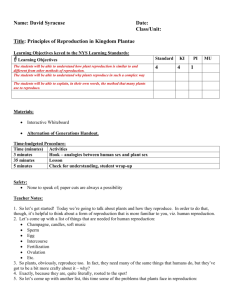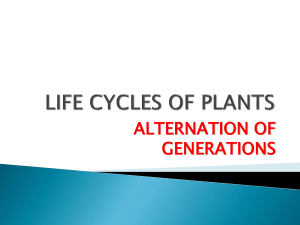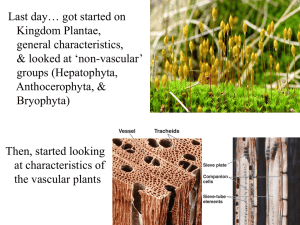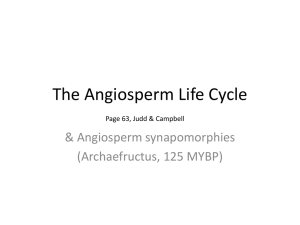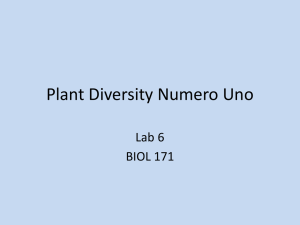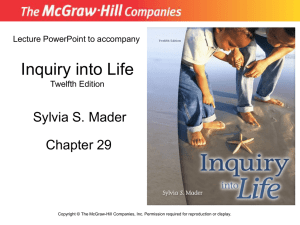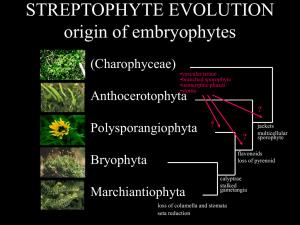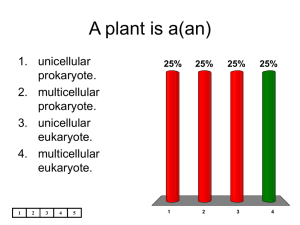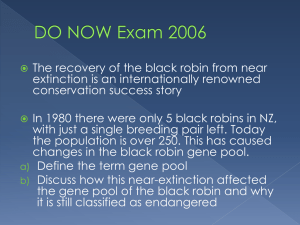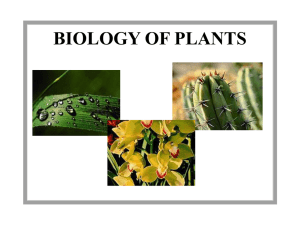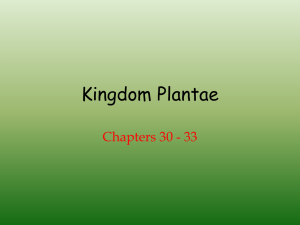Seed plants
advertisement
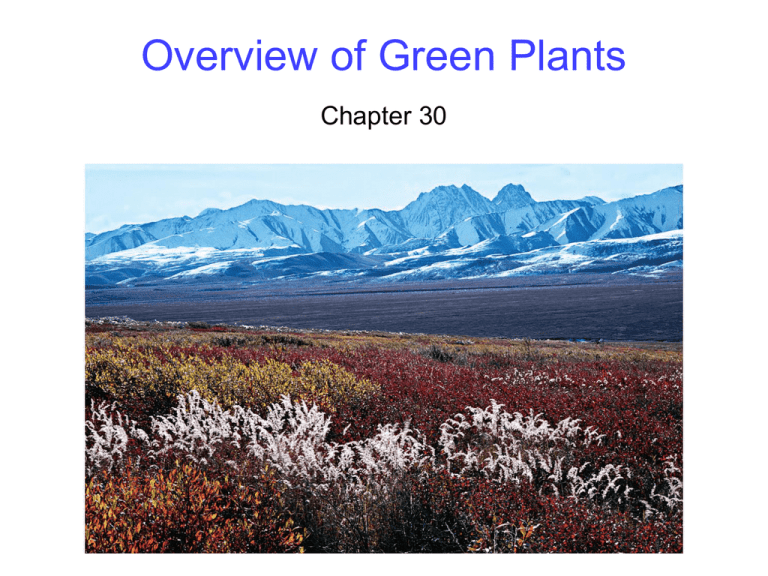
Overview of Green Plants Chapter 30 Defining Plants • The kingdom Viridiplantae includes land plants and green algae – Red and brown algae are excluded • The green algae split into two major clades – Chlorophytes – Charophytes • Streptophyta includes the Charophytes and all land plants • All green plants arose from a single species of freshwater algae 2 Defining Plants 3 Defining Plants • Land plants have two major features 1. Protected embryos 2. Multicellular haploid and diploid phases 4 Defining Plants Adaptations to terrestrial life • Evolution of leaves that increase photosynthetic surface area • Protection from desiccation by a waxy cuticle and stomata • Shift to a dominant vertical diploid generation 5 Plant Life Cycles • Humans have a diplontic life cycle – Only the diploid stage is multicellular Plants have a haplodiplontic life cycle – Multicellular diploid stage = Sporophyte – Multicellular haploid stage = Gametophyte • Plants have an alternation of generation – sporophyte → gametophyte → sporophyte → etc. 6 Plant Life Cycles • Sporophyte (2N) produces haploid spores (N) by meiosis • Spores (N) divide by mitosis producing the gametophyte (N) • Gametophyte (N) produces gametes (N) by mitosis • Gametes (N) fuse to form the diploid sporophyte (2N) 7 The General Plant Life Cycle process process process 8 Plant Life Cycles As more complex plants evolved: • Diploid stage (sporophyte) became the dominant portion of the life cycle • Gametophyte became more limited in size • Sporophyte became nutritionally independent 9 Chlorophytes • Chlorophytes, sister taxa of the Streptophytes, are a diverse group including: • Chlamydomonas – Unicellular chlorophyte with two flagella – Have eyespots to direct swimming – Reproduces asexually as well as sexually 10 Chlorophytes • Volvox – Colonial chlorophyte – Hollow sphere of a single layer of 500-60,000 cells – A few cells are specialized for reproduction 11 Chlorophytes • Ulva – Multicellular chlorophyte – True haplodiplontic life cycle – Gametophyte and sporophyte have identical appearance 12 Ulva life cycle MITOSIS 13 Charophytes • Charophytes are green algae related to land plants Land plants 14 Charophytes • Charales (300 species) – Macroscopic – Plant-like plasmodesmata – Sister clade to land plants • Choleocaetales (30 species) – Microscopic – Plant-like mitosis – Next closest plant relatives 15 Bryophytes • Bryophytes are the closest living descendants of the first land plants – Called nontracheophytes because they lack tracheids (specialized transport cells) – Simple, but highly adapted to diverse terrestrial environments – Non-photosynthetic sporophyte is nutritionally dependent on the gametophyte – 3 groups: liverworts, hornworts and mosses 16 Bryophytes • Liverworts (phylum Hepaticophyta) – Have flattened gametophytes with liver-like lobes – Form gametangia in umbrella-shaped structures – Also undergo asexual reproduction 17 Bryophytes • Hornworts (phylum Anthocerotophyta) – Sporophyte has stomata – Sporophyte is photosynthetic – Cells have a single large chloroplast 18 Bryophytes • Mosses (phylum Bryophyta) – Gametophytes consist of small, leaflike structures around a stemlike axis – Anchored to substrate by rhizoids – Multicellular gametangia form at the tips of gametophytes • Archegonia – Female gametangia • Antheridia – Male gametangia – Mosses withstand drought, but not air pollution 19 Moss Reproduction 20 Tracheophyte Plants • Cooksonia, the first vascular land plant, appeared about 420 MYA – Only a few centimeters tall – No roots or leaves – Homosporous (spores are the same size and type) 21 Tracheophyte Plants • Vascular tissues are of two types – Xylem – Conducts water and dissolved minerals upward from the roots • contains tracheids – Phloem – Conducts sucrose and hormones throughout the plant • These enable enhanced height and size in the tracheophytes • Tracheophytes are also characterized by the presence of a cuticle and stomata 22 Tracheophyte Plants • Vascular plants have gametophytes reduced in size and complexity relative to sporophytes • Seeds – Highly-resistant structures that protect the plant embryo – Occur only in heterosporous plants • Fruits in flowering plants add a layer of protection to seeds – Also attract animals that disperse seeds 23 Tracheophytes • Vascular plants (tracheophytes) include seven extant phyla grouped in three clades – Lycophytes (club mosses) – Pterophytes (ferns and their relatives) – Seed plants 24 Lycophytes • Club mosses are the earliest vascular plants – They lack seeds – Superficially resemble true mosses but they are not related – Homosporous or heterosporous 25 Pterophytes • The phylogenetic relationships among ferns and their relatives is still being sorted out 26 Pterophytes • Whisk ferns – Saprophyte consists of evenly forking green stems without leaves or roots – Some gametophytes develop elements of vascular tissue – Often symbionts with fungi 27 Pterophytes • Horsetails – All 15 living species are homosporous – Constitute a single genus, Equisetum – Consist of ribbed, jointed photosynthetic stems that arise from branching rhizomes – High silica content in stems made them useful as “scouring rushes” 28 Pterophytes • Ferns – The most abundant group of seedless vascular plants with about 11,000 species – The conspicuous sporophyte and much smaller gametophyte are both photosynthetic 29 Pterophytes • The fern life cycle differs from that of a moss – Much greater development, independence and dominance of the fern’s sporophyte • Fern morphology – Sporophytes have rhizomes – Fronds (leaves) develop at the tip of the rhizome as tightly rolled-up coils then uncoil and expand 30 Pterophytes Uncoiled fronds are called “fiddleheads” and are a delicacy among northern First Nation peoples 31 Pterophytes 32 Pterophytes • Fern reproduction – Most fern are homosporous – Produce distinctive sporangia in clusters called sori on the back of the fronds – Diploid spore mother cells in sporangia produce haploid spores by meiosis – At maturity, the spores are catapulted by snapping action 33 Seed Plants • Seed plants first appeared 305-465 MYA – Evolved from spore-bearing plants known as progymnosperms • The seed represents an important advance – Protects the embryo – Easily dispersed – Introduces a dormant phase in the life cycle 34 Seed Plants • Seed plants produce 2 kinds of gametophytes – Male gametophytes • Pollen grains • Dispersed by wind or a pollinator – Female gametophytes • Develop within an ovule • Enclosed within diploid sporophyte tissue 35 Seed Plants • There are two types of seed plants – Gymnosperms are plants with “naked seeds” • Ovule is exposed on a scale at pollination • All lack flowers and fruits of angiosperms – Angiosperms are flowering plants • Ovules are enclosed in diploid tissue at pollination • The carpel (modified leaf) covers seeds and develops into fruit 36 Gymnosperms • There are four living groups – Cycadophytes – Gnetophytes – Ginkgophytes – Coniferophytes 37 Gymnosperms • Cycads (phylum Cycadophyta) – Slow-growing gymnosperms of tropical and subtropical regions – Sporophytes resemble palm trees – Have largest sperm cells of all organisms! 38 Gymnosperms • Gnetophytes (phylum Gnetophyta) – Only gymnosperms with vessels in their xylem – Contain three (unusual) genera • Welwitschia • Gnetum • Ephedra – ephedrine can be extracted from species of this genus 39 Gymnosperms • Ginkgophytes (phylum Ginkgophyta) – Only one living species remains • Ginkgo biloba – Dioecious • Male and female reproductive structures form on different trees 40 Gymnosperms • Conifers (phylum Coniferophyta) are the largest gymnosperm phylum and include: – Pines, spruces, firs, cedars and others – Coastal redwood – Tallest tree – Bristlecone pine – Oldest living tree • Conifers are sources of important products • Timber, paper, resin and taxol (anti-cancer) 41 Gymnosperms • Pines – More than 100 species, all in the Northern hemisphere – Produce tough needlelike leaves in clusters – Leaves have: • Thick cuticle and recessed stomata • Canals into which cells secrete resin 42 Pine reproduction 43 Angiosperms • Angiosperm origins are a mystery • The oldest known angiosperm in the fossil record is Archaefructus • The closest living relative to the original angiosperm is Amborella 44 Angiosperms 45 Angiosperms • Flower morphology – Primordium develops into a bud at the end of a stalk called the pedicel – Pedicel expands at the tip to form a receptacle, to which other parts attach – Flower parts are organized in circles called whorls 46 Angiosperms • Flower morphology – Outermost whorl = Sepals – Second whorl = Petals – Third whorl = Stamens (androecium) • Each stamen has a pollen-bearing anther and a filament (stalk) – Innermost whorl = Gynoecium • Consists of one or more carpels that house the female gametophyte 47 Angiosperms The ovary eventually develops into the plant’s fruit 48 Angiosperm Reproduction 49
